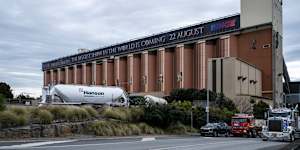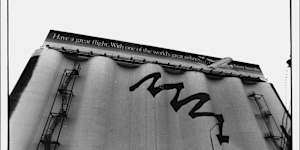The NSW Independent Planning Commission approved the short-term extension to the consent for the billboard after finding the signs were not at odds with the character of the industrial port. The silos are at the heart of the Bays West precinct,which the government wants to transform into a residential,commercial and leisure hub.

Thousands of motorists on the Anzac Bridge in Sydney’s inner west pass the advertisements each day.Louie Douvis
Eye Drive Sydney,a subsidiary of advertising company oOh!media,last year submitted a proposal to the NSW Department of Planning seeking to extend its consent for the advertising billboard for another 10 years to 2032.
The billboard was erected in the 1990s as part of Sydney’s bid for the 2000 Olympic Games and was originally approved for 10 years. The City of Sydney said rolling extensions to the development consent were at odds with the intent of the original application,and the future character of the area. It wanted the billboard removed.
City planning director Graham Jahn said in a submission on the proposal the sign had “perpetuated a permanent blight on the Sydney skyline and has completely undermined the relevance of time-limited consents”.
The Inner West Council,which covers Glebe Island,did not object to the plan. Under the proposal,Eye Drive Sydney said it would pay the council $127,000 a year during the agreement to fund conservation works.

The silos,pictured in 1993,were painted with a mural to support Sydney’s bid for the 2000 Olympic Games. Now-defunct airline Ansett was one of the first advertisers on the billboard.Steve Christo
The application was referred to the commission because it attracted more than 50 negative submissions.
About 80 objections to the initial proposal,summarised by the commission,variously described the billboards as “an eyesore”,“visually overbearing”,“tacky” and “horribly ugly”.
The Glebe Society raised concerns about light spilling into homes opposite the billboard,which has typically been lit up from dusk to 1am.
The silos were built in the 1920s to store sugar and cement. Heritage NSW said extending the consent would not adversely affect the structures,nor the nearby heritage-listed White Bay Power Station and Glebe Island Bridge.
The Bays West precinct from Pyrmont to Balmain is earmarked for a.
The Planning Department had recommended the application for approval,with draft conditions requiring a three-year extension to 2025.
In a decision this month,a two-member IPC panel said the approval included a condition to turn the sign’s lights off at 11pm,and a requirement to remove the billboard within three months of the development consent lapsing.
“The commission acknowledges that this precinct will undergo significant change in the coming years,and considers a time-limited consent to be appropriate to ensure the signage does not adversely constrain future development,” the commission said in its decision.
Each day an estimated 130,000 motorists on the Anzac Bridge pass the billboard,which was once touted as the largest in the southern hemisphere.
Industry publication in late 2013 that the billboard was the most expensive to rent in Australia,at a cost of $250,000 per 28 days,and was typically booked out six months in advance.
The Morning Edition newsletter is our guide to the day’s most important and interesting stories,analysis and insights..